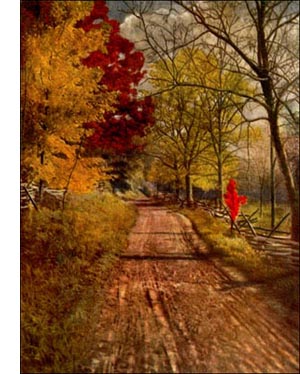Black Walnut Tree
 Black Walnut (Juglans nigra, Linn.)-A majestic, spreading tree, 80 to 150 feet high, with tall trunk, 4 to 6 feet through. Bark dark brown, furrowed, scaly. Wood dark purplish brown, with silvery lustre; hard, fine grained, heavy, strong, durable in contact with soil. Buds: terminal, flattened, silky, tomentose; axillary, small, globose, silky; flower buds naked. Leaves alternate, 12 to 24 inches long, odd pinnate of 13 to 25 leaflets, ovatelanceolate, serrate, pubescent beneath, 3 to 3 1/2 inches long, sessile on leaf stem; yellow-green, becoming yellow in autumn; petioles downy. Flowers, May, with leaves, greenish, monoecious, staminate in catkins 3 to 6 inches long on wood of preceding year; pistillate on new shoots, in axillary few-flowered clusters, or solitary; stigmas red, prominent. Fruit 1 to 2 in almost sessile clusters, globose 1 1/2 to 2 inches in diameter; husk yellow-green, pitted, strongly aromatic, spongy, indehiscent; shell hard, deeply sculptured, kernel convoluted, oily, sweet, edible. Preferred habitat, rich woods. Distribution, southern Ontario to Florida, west to Nebraska and Texas. Uses: Fine shade and park tree; lumber valuable for veneering furniture, interior finish of houses, gun stocks and coffins, and for boat and shipbuilding. Nuts locally commercial. Husks occasionally used for dyeing and tanning.
Black Walnut (Juglans nigra, Linn.)-A majestic, spreading tree, 80 to 150 feet high, with tall trunk, 4 to 6 feet through. Bark dark brown, furrowed, scaly. Wood dark purplish brown, with silvery lustre; hard, fine grained, heavy, strong, durable in contact with soil. Buds: terminal, flattened, silky, tomentose; axillary, small, globose, silky; flower buds naked. Leaves alternate, 12 to 24 inches long, odd pinnate of 13 to 25 leaflets, ovatelanceolate, serrate, pubescent beneath, 3 to 3 1/2 inches long, sessile on leaf stem; yellow-green, becoming yellow in autumn; petioles downy. Flowers, May, with leaves, greenish, monoecious, staminate in catkins 3 to 6 inches long on wood of preceding year; pistillate on new shoots, in axillary few-flowered clusters, or solitary; stigmas red, prominent. Fruit 1 to 2 in almost sessile clusters, globose 1 1/2 to 2 inches in diameter; husk yellow-green, pitted, strongly aromatic, spongy, indehiscent; shell hard, deeply sculptured, kernel convoluted, oily, sweet, edible. Preferred habitat, rich woods. Distribution, southern Ontario to Florida, west to Nebraska and Texas. Uses: Fine shade and park tree; lumber valuable for veneering furniture, interior finish of houses, gun stocks and coffins, and for boat and shipbuilding. Nuts locally commercial. Husks occasionally used for dyeing and tanning.The early settlers did not realise the folly they committed by chopping down black walnut trees, rolling them together and burning them. They were clearing the land to make farms, and trees were weeds they had to conquer. They did not discriminate between species in the general holocaust. They knew that black walnut was durable, so made fence posts and rails of it. Besides, this wood split easily.
The peculiar fitness of black walnut wood for gun stocks and for furniture was realised later. Trees were sacrificed by thousands to supply the home and foreign markets, and only Nature planted for the generations to come. The result is the present shortage of walnut lumber, and its excessive price. Enterprising individuals go into cleared ground and pull the stumps of trees long dead. They are still sound, and there is valuable veneering stuff in the most of them. Old and worn furniture of solid black walnut is bought and sawed thin for the same purpose. Do we realise yet the usefulness and the beauty of black walnut wood? The silvery grain, the rich, violet-purple tones in the brown heart wood, the exquisite shading of its curly veinings, and the lasting qualities of the wood? If we did, we would plant groves of it.
As a fruit tree the black walnut has limitations. The oil in the kernel soon becomes rancid, so that there can be but a local market for the nuts, though they are very good for a time, when carefully dried.
The black walnut is majestic as a shade tree-a noble ornament to parks and pleasure grounds. It needs room and distance to show its luxuriant crown and stately trunk to advantage. Then no tree excels it. "It unites almost all the qualities desirable in a tree: beauty, gracefulness and richness of foliage in every period of its growth." The bark and husks may be employed in the important arts of dyeing and tanning. The fruit is a food, and yields a valuable oil. The wood is one of the most useful and most elegant.
The growth of the black walnut is rapid and sure from the seed. Nuts gathered in the autumn should be stratified in gravel over winter, and planted next spring. The way to restore what we have lost is to plant walnuts wherever there is a place suitable for such a tree.